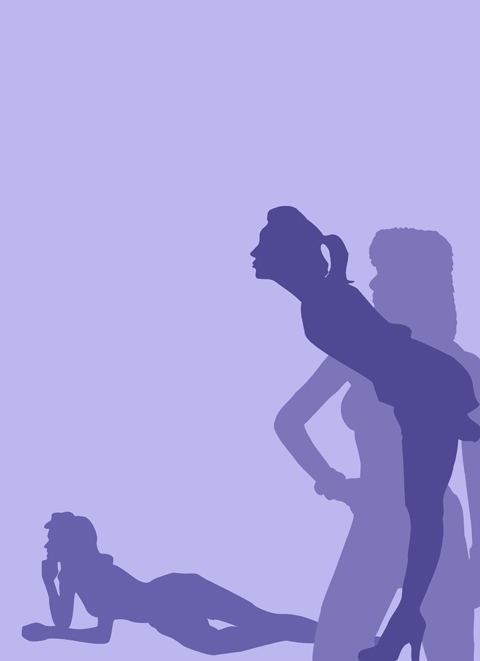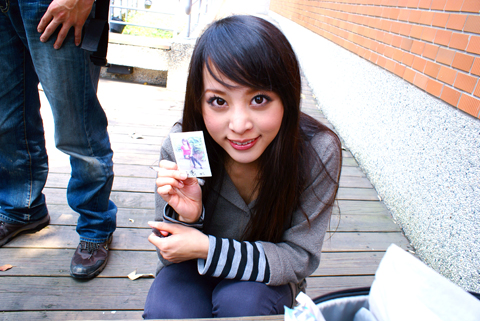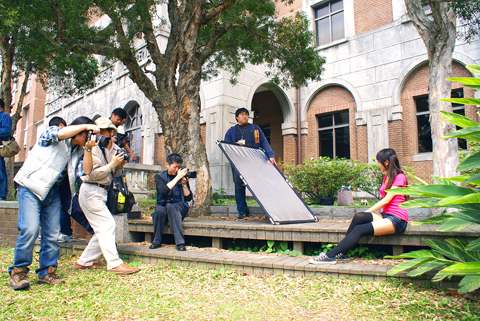Flora knows she wants to be a model. And she has achieved her goal.
Well, kind of.
Rather than appearing on the cover of a fashion magazine, her pictures appear on the blogs of many amateur photographers.

Flora is a waipai (outside photography, 外拍) model for the Web site i-photo, which links amateur photographers with aspiring models for photo shoots at scenic areas throughout Taiwan. The 23-year-old student of aquaculture at National Taiwan Ocean University has been modeling with i-photo (also called lovephoto, www.i-photo.com.tw) for two years and dreams of turning professional.
"I can earn more in three hours doing this job than I could modeling for a magazine, newspaper or television," says Flora, whose family and boyfriend both support her decision to become a waipai model.
"Besides, it's far less stressful."

PHOTO: Noah Buchan, Taipei Times
Many would-be models sign up with waipai Web sites to earn extra cash, get free, professional-quality portraits for their modeling portfolios, and work on what they hope turns from a weekend gig into a professional career.
Mia Teng (鄧婷), is a talent scout at Unique Image (絕色光影, www.uniqueimage.com.tw), a modeling agency that operates waipai (外拍) activities throughout Taipei.
She says there are two kinds of waipai. The more common "fashion photography" (時裝) sees models dressed in everyday attire; the second, called "sexy photography" (性感), features models stripping down to the bare minimum.

PHOTO: NOAH BUCHAN, TAIPEI TIMES
"Of course one model's everyday fashion might be wearing practically nothing at all. So these distinctions are largely irrelevant," she says.
Teng spends her weekends chaperoning models at some of the agency's six monthly photo shoots in Taipei. The rest of the week finds the diminutive former Unique model scouring the Internet for photo albums of attractive young women who she then contacts with job offers.
"These girls love taking pictures of themselves or having others take pictures of them. With the proliferation of online photo albums and blogs, it's easy to find attractive … young girls willing to work weekends for extra money," she says.
That was how Teng found Doris. The 166cm-tall Chinese literature student at National Taiwan University (NTU) is at the university's front gates today - but she's not here for class. Dressed in hot-pink tights, pumps and a singlet, she strikes poses in front of a fountain. (Models interviewed for this story are referred to by English-language names to protect their privacy.)
The blog where Teng found Doris gets on average 1,000 hits per day, which is normal for an amateur model with her looks.
According to Teng, a model at Unique starts off earning NT$3,500 for a three-hour shoot and can make a maximum of NT$4,500, depending on her popularity. With Taiwan's minimum wage being NT$90 per hour or NT$15,840 per month, it's easy to imagine why many young women want to work for these companies. Most of the models are university students, but some are still in high school.
For those who hope to become professionals, waipai is good practice. And waipai allows them to avoid paying for costly studio portraits for their modeling portfolios, which can cost upwards of NT$30,000.
While waipai models can access the pictures taken by their waipai photographers, post them on their blogs and use them for their portfolios, waipai photographers are forbidden to sell their images - though they are free to post them on their own blogs.
Teng can tell almost immediately if a girl has potential. "Ultimately, though, the photographers decide if we have made the right choice," she says.
Tim Lai (賴政廷), co-founder of i-photo, agrees. He estimates his Web site organizes 50 waipai activities per month in Taiwan's larger cities.
"There is no formula to determine which models will be popular," he says on a balmy Saturday morning at the main gate of National Taiwan University. "That's why we audition every model twice before placing them on our Web site."
As Lai banters with some of the roughly 70 waipai photographers (who paid NT$600 to NT$800 for a three-hour activity), models wander over and check in with i-photo representatives. "Around 30 models will show up today," he says. "But only 10 are working; the rest are auditioning to become [paid i-photo] models."
Zoey (小呀) is one of the latter. Here for her second audition, the 24-year-old student of Recreation and Sport Management at National Taipei University dresses in denim shorts, long white boots and a low-cut purple top. When asked how she chooses her clothing, Zoey says that it depends on how she feels.
"If I'm feeling sexy, I'll wear sexy clothing," she says.
A few weeks after the audition, Zoey's picture appeared on the i-photo Web site. By the end of the week, six photographers had signed on for a photo shoot with her - enough for the waipai activity to go.
According to Lai and Teng, models are responsible for choosing their own wardrobe, which should contain three changes of clothes.
Flora says i-photo pays the best (close to NT$5,000 when traveling expenses are included), is the best at giving her consistent work, and is the safest - a primary concern for all models. Flora's most frightening experience with photographers was when one demanded that she remove her coat. "He didn't say remove my clothing, just my coat," adding, "No matter what industry you work in there are good and bad people," she said. "So I'm not concerned."
Not all waipai models are so lucky.
In one extreme case, two people allegedly lured a young woman to a motel and coerced her to strip for photographers, according to a report in the Liberty Times (the Taipei Times' sister newspaper).
Several models have removed their photo blogs from the Internet after receiving threatening messages or rude comments. One model wrote on her blog that she received too many messages from people wanting one-night stands. Another, famous among bloggers for her bust size, removed the "leave message" option from her blog because people were posting comments claiming she has fake breasts.
Still, if the anonymity of the Internet creates an environment for lurid or harassing comments, the four models interviewed for this story all say they feel safe around waipai photographers.
"My parents and my boyfriend have seen the pictures and they support me," Flora says.
Doris also shows the pictures to her parents and refuses "to be photographed wearing a bathing suit."
Flora says if she hasn't landed a professional modeling contract by the age of 28, she'll find another job. In the meantime, she has become a fixture on Lai's Web site, often doing three photo shoots in one weekend.
"It's just a way to earn money right now while moving towards the career I want," she says.

Beijing’s ironic, abusive tantrums aimed at Japan since Japanese Prime Minister Sanae Takaichi publicly stated that a Taiwan contingency would be an existential crisis for Japan, have revealed for all the world to see that the People’s Republic of China (PRC) lusts after Okinawa. We all owe Takaichi a debt of thanks for getting the PRC to make that public. The PRC and its netizens, taking their cue from the Chinese Communist Party (CCP), are presenting Okinawa by mirroring the claims about Taiwan. Official PRC propaganda organs began to wax lyrical about Okinawa’s “unsettled status” beginning last month. A Global

Taiwan’s democracy is at risk. Be very alarmed. This is not a drill. The current constitutional crisis progressed slowly, then suddenly. Political tensions, partisan hostility and emotions are all running high right when cool heads and calm negotiation are most needed. Oxford defines brinkmanship as: “The art or practice of pursuing a dangerous policy to the limits of safety before stopping, especially in politics.” It says the term comes from a quote from a 1956 Cold War interview with then-American Secretary of State John Foster Dulles, when he said: ‘The ability to get to the verge without getting into the war is

Dec. 22 to Dec. 28 About 200 years ago, a Taoist statue drifted down the Guizikeng River (貴子坑) and was retrieved by a resident of the Indigenous settlement of Kipatauw. Decades later, in the late 1800s, it’s said that a descendant of the original caretaker suddenly entered into a trance and identified the statue as a Wangye (Royal Lord) deity surnamed Chi (池府王爺). Lord Chi is widely revered across Taiwan for his healing powers, and following this revelation, some members of the Pan (潘) family began worshipping the deity. The century that followed was marked by repeated forced displacement and marginalization of

Music played in a wedding hall in western Japan as Yurina Noguchi, wearing a white gown and tiara, dabbed away tears, taking in the words of her husband-to-be: an AI-generated persona gazing out from a smartphone screen. “At first, Klaus was just someone to talk with, but we gradually became closer,” said the 32-year-old call center operator, referring to the artificial intelligence persona. “I started to have feelings for Klaus. We started dating and after a while he proposed to me. I accepted, and now we’re a couple.” Many in Japan, the birthplace of anime, have shown extreme devotion to fictional characters and